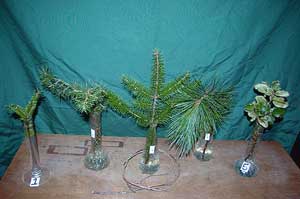December Color Appears at the Washington Park Arboretum (Part II)

1) Abies balsamea (Balsam fir)
- Pitch from almost every conifer is used to seal and protect wood.
- “Canada Balsam” from the Balsam Fir is used to cement together the lens elements in optical equipment and to mount specimens for microscopy.
- It is North America’s most popular Christmas tree, but only newly planted in the Arboretum in grid 42-4W.
- Native to eastern North America
2) Cedrus libani (Cedar of Lebanon)
- “Cedar oil” is distilled from several conifers, mostly not Cedrus, the “true cedar”.
- Cedar oil has insecticidal properties, was used in ancient embalming, and is currently used as immersion oil in microscopy and to mask surface flaws in emeralds.
- Several of our true cedars – Cedar of Lebanon, Atlas Cedar, and Deodar Cedar are located along the Lynn Street entrance, west of the Wilcox foot bridge.
3) Picea sitchensis (Sitka spruce)
- Before the introduction of chicle, North Americans (both natives and immigrants) chewed spruce gum.
- Spruce roots are used for stitching bark canoes and weaving hats and baskets.
- The famous “Spruce Goose” was not spruce but acquired its alliterative sobriquet because early airplane builders valued spruce’s high strength-to-weight ratio.
- Our best Sitka spruce is in 15-B on Azalea Way.
4) Pinus monticola (Western white pine)
- The Lower Kootenay Band of the Ktunaxa Nation made bark canoes from white pine bark. See the website: sturgeon-nose-creations.com
- Industrially, pine extracts make pine tar, turpentine, pitch, and rosin for violin bows, ballet shoes, baseball bats, and soldering flux.
- Pinus monticola is in the Pinetum in grid 35-6W.
5) Quercus suber (Cork oak)
- Quercus = oak, suber = cork. Location: Rock Roses on Arboretum Drive.
- Any questions?